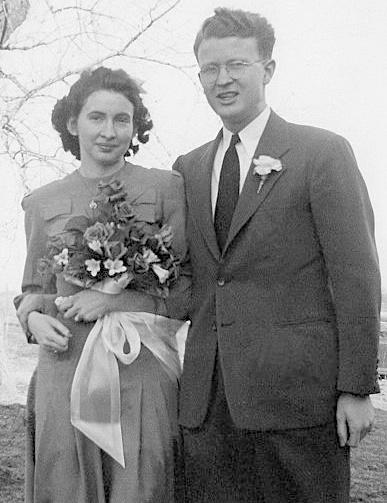An Untold Life: Faye Franks
Faye and husband Kermit at their wedding at Faye’s parents’ farm in Kansas.
Thu, 04/11/2013
By Maggie Nicholson
Faye Franks was born on a small farm in 1918 in rural Kansas. Her parents, Ebon Rollo and Mattie Mabel Anderson, saw right away, that Faye was a strong and gifted child. The one-room schoolhouse teacher, who periodically boarded with students’ families, grew to know Faye and learned of her aptitude while staying at the farm. Though Faye was soon reading, her father would not allow her to attend school until she turned six the following February. She was then encouraged to pursue education, and she followed this counsel, thoroughly.
Faye and Kermit met in the fall of 1941. Both were teaching high school students in a small town called Eudora. The two had recently graduated from the University of Kansas. There were four single teachers at the school, who began double dating as a group. Faye and Kermit fell swiftly in love. On December 7th, 1941, the United States entered into World War II, and Faye and Kermit decided to marry before Kermit was to be drafted. On his way to the wedding, he picked up his induction notice. Faye stitched together her own wedding dress, a solid, slender fitting garment, fashioned of pink wool. The two were married in the farmhouse. Chickens wandered through guests at the outdoor reception. Ten days later, Kermit left for the army.
He served in Alaska for a number of years, and as the war came to a close, was stationed at the Armed Forces Institute on the University of Washington campus. Faye had continued teaching in Kansas in his absence. When he was stationed in Seattle, she moved to Washington, where they lived together for the first time since they had married.
Faye and Kermit had four children: Marsha, Dean, David, and Candace. Marsha and her sister Candace followed in their parents’ footsteps, becoming teachers. David worked for the postal service, and Dean became a federal administrative judge.
As a mother, Faye was a Girl Scout and Cub Scout leader, Sunday school teacher, and P.T.A. president. She never had to “ground” her children. They felt her authority not through punishment, but through a will to make her proud.
Faye made both of her daughters their wedding dresses and nearly all of their clothes as they were growing up. Three of her granddaughters also wore wedding dresses fashioned by her. She liked creating something out of nothing. At the Tibbetts United Methodist Church rummage sale, she would purchase things she worried wouldn’t “find a good home.” At the couple’s summer cabin, she used old apple boxes and orange crates as shelves.
From 1948 to 1957 Faye and Kermit lived in a small house three blocks from the steel mill. Their older children attended the Old Cooper School. The house by the mill had a big backyard with a pear tree, the fruits of which Faye would collect and can. She and her children went on road trips to Yakima to pick cherries, which they would freeze and make jam with. She canned blackberries, cherries and tomatoes.
When the family grew, they moved to a larger house near the present-day Jefferson Square, where they lived for nearly fifty years. The house had wooden floors. Her braided rugs slept in sunlight patches, and African violets lined the windowsills. Gifts decorated the corners, and throughout the home, her children's artwork hung on sturdy nails. Azaleas, notoriously difficult to keep alive, were a favorite of Faye’s. She was able to keep them blooming year after year.
Faye and Kermit had large groups of friends. Faye was part of a group that called themselves ‘The West Seattle Girls.’ They would congregate monthly to sew, chat and eat desserts well into the evening, while their husbands watched the kids. Faye and Kermit loved and nurtured each other. They were part of two square dancing groups, hiked and backpacked Washington forests, and remained in love well into their old age. They celebrated their 70th wedding anniversary in February of 2012, just before Faye’s final illness.
Faye and Kermit also worked together at the Seabeck Conference Center, which they managed as a pair, each summer from 1961 through 1975. Kermit hired the summer staff, which included their children, and Faye managed the dining room service. The summer staff and the Franks all resided in dormitory-style living at Seabeck. There are, to this day, staff reunions. Those who attend recall their days working with the Franks at the Seabeck as their happiest memories, where they felt most like part of a real family.
In the 1960’s, Faye and Kermit began hosting foreign exchange students through the International Christian Youth Exchange, many of whom were sponsored by the Tibbetts Church. They hosted nine students over the years. Each lived with the Franks for one year. Some went there directly. Others had trouble in their first homes and wound up at the Franks’. No one left once they made it to Faye and Kermit.
One young man they hosted, Leonardo, came from Honduras with an interest in medicine. He did volunteer work at a Seattle hospital and later became a physician in Honduras. Leo stayed in contact with Faye, Kermit, their children, and grandchildren. When he learned of Faye’s final illness, he called immediately.
“I’m coming,” said Leo. He took an absence from his medical practice in Honduras to visit Faye for three days, staying with her at her bedside. Faye had changed his life, and had lightened his heart. This is an effect she had on many: her children, friends, husband, as well as those whose fortune it was to have been taken up in her home and loving arms.




